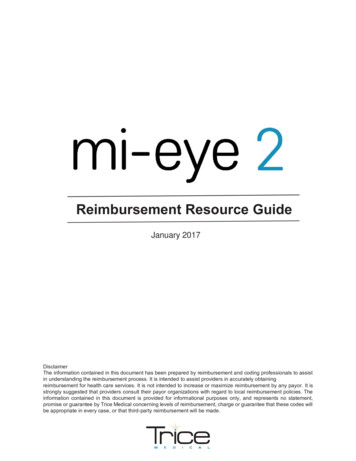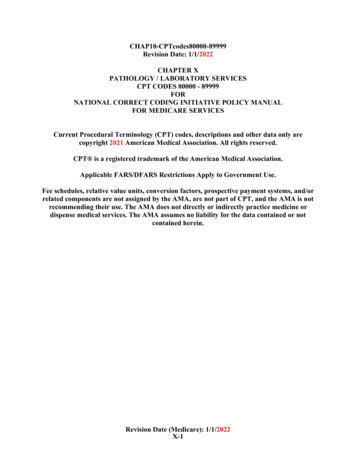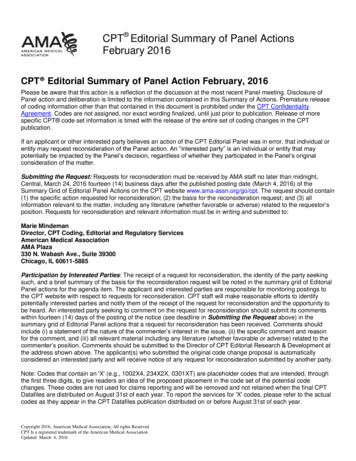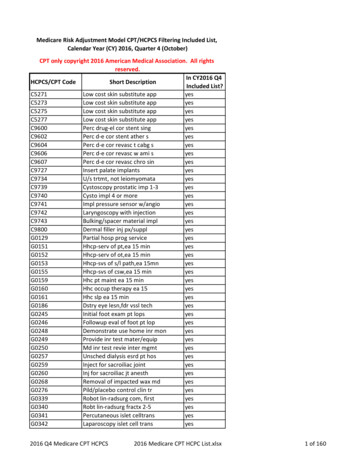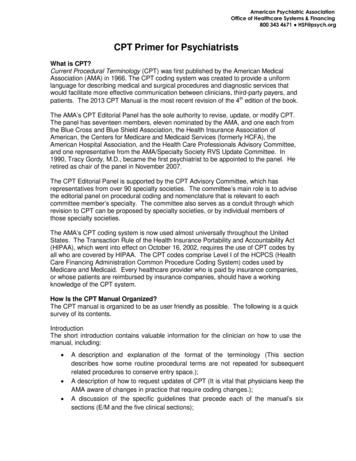
Transcription
American Psychiatric AssociationOffice of Healthcare Systems & Financing800 343 4671 HSF@psych.orgCPT Primer for PsychiatristsWhat is CPT?Current Procedural Terminology (CPT) was first published by the American MedicalAssociation (AMA) in 1966. The CPT coding system was created to provide a uniformlanguage for describing medical and surgical procedures and diagnostic services thatwould facilitate more effective communication between clinicians, third-party payers, andpatients. The 2013 CPT Manual is the most recent revision of the 4th edition of the book.The AMA’s CPT Editorial Panel has the sole authority to revise, update, or modify CPT.The panel has seventeen members, eleven nominated by the AMA, and one each fromthe Blue Cross and Blue Shield Association, the Health Insurance Association ofAmerican, the Centers for Medicare and Medicaid Services (formerly HCFA), theAmerican Hospital Association, and the Health Care Professionals Advisory Committee,and one representative from the AMA/Specialty Society RVS Update Committee. In1990, Tracy Gordy, M.D., became the first psychiatrist to be appointed to the panel. Heretired as chair of the panel in November 2007.The CPT Editorial Panel is supported by the CPT Advisory Committee, which hasrepresentatives from over 90 specialty societies. The committee’s main role is to advisethe editorial panel on procedural coding and nomenclature that is relevant to eachcommittee member’s specialty. The committee also serves as a conduit through whichrevision to CPT can be proposed by specialty societies, or by individual members ofthose specialty societies.The AMA’s CPT coding system is now used almost universally throughout the UnitedStates. The Transaction Rule of the Health Insurance Portability and Accountability Act(HIPAA), which went into effect on October 16, 2002, requires the use of CPT codes byall who are covered by HIPAA. The CPT codes comprise Level I of the HCPCS (HealthCare Financing Administration Common Procedure Coding System) codes used byMedicare and Medicaid. Every healthcare provider who is paid by insurance companies,or whose patients are reimbursed by insurance companies, should have a workingknowledge of the CPT system.How Is the CPT Manual Organized?The CPT manual is organized to be as user friendly as possible. The following is a quicksurvey of its contents.IntroductionThe short introduction contains valuable information for the clinician on how to use themanual, including: A description and explanation of the format of the terminology (This sectiondescribes how some routine procedural terms are not repeated for subsequentrelated procedures to conserve entry space.);A description of how to request updates of CPT (It is vital that physicians keep theAMA aware of changes in practice that require coding changes.);A discussion of the specific guidelines that precede each of the manual’s sixsections (E/M and the five clinical sections);
American Psychiatric AssociationOffice of Healthcare Systems & Financing800 343 4671 HSF@psych.org A discussion of ―add-on codes‖ for additional or supplemental procedures;An explanation of code modifiers and how they are to be used;A brief discussion of how place of service relates to CPT;A discussion of the inclusion of codes for unlisted procedures or services in eachsection;A note that some CPT codes require interpretation and reporting if they are to beused;A note that special reports may be required to determine the medical appropriateness of rare or very new services;A discussion of how to identify code changes from year to year;A reference to the expanded alphabetical index now included in the Manual;A note on how to obtain electronic versions of CPT; and finally How references to AMA resources on the CPT codes are noted in the Manual. Illustrated Anatomical and Procedural ReviewThis section provides a review of the basics of anatomy and medical vocabulary that arenecessary for accurate coding. Lists of prefixes, suffixes, and roots are given, followed by22 anatomical illustrations. There is also an index of all the procedural illustrations thatappear throughout the manual, listed by their corresponding codes.Molecular PathologyThis is a new section in 2013.Evaluation and Management CodesAlthough the rest of the CPT manual is organized according to the numerical order of thecodes, the evaluation and management (E/M) codes, 99xxx, are provided in the first codesection because they are used by physicians in all specialties to report a considerablenumber of their services. The E/M codes are preceded by tables that indicate therequired components for the various E/M codes and fairly extensive guidelines that definethe terms used in the code descriptors and provide instructions for selecting the correctlevel of E/M service.Major Clinical SectionsNext come the major clinical sections: Anesthesia, Surgery, Radiology, Pathology andLaboratory, and Medicine. Each of these sections is preceded by guidelines. Thepsychiatry codes, 908xx, are found in the Medicine section. The codes in the Psychiatrysubsection cover most of the services mental health professionals provide to patients inboth inpatient and outpatient settings.Category II and III CodesThe Medicine section is followed by a listing of the supplemental Category II andCategory III codes. These codes are generally optional codes used to facilitate datacollection and are never used as substitutes for the standard Category I CPT codes.Category II codes are used for performance measurement. According to the CPTManual, Category II codes are ―intended to facilitate data collection about the quality ofcare rendered by coding certain services and test results that support nationallyestablished performance measures and that have an evidence base as contributing to
American Psychiatric AssociationOffice of Healthcare Systems & Financing800 343 4671 HSF@psych.orgquality patient care.‖ These codes will be used more and more as Medicare attempts toshift from volume-based payment to quality-based payment.Category III codes are temporary codes that are used to allow data tracking for emergingservices and procedures.Appendixes and IndexThe last section of the manual includes appendixes and an extensive alphabetical index.There are 13 appendixes:1. Appendix A: Modifiers—modifiers are two-digit suffixes that are added to CPT codesto indicate that the service or procedure has been provided under unusualcircumstances (e.g., –21, which indicates a prolonged E/M service) (See Appendix Bof this book for a list of modifiers.)2. Appendix B: Summary of Additions, Deletions, and Revisions (of codes in the currentmanual)3. Appendix C: Clinical Examples—provides clinical examples to clarify the use of E/Mcodes in various situations4. Appendix D: Summary of CPT Add-On Codes—codes used to denote procedurescommonly carried out in addition to a primary procedure5. Appendix E: Summary of CPT Codes Exempt From Modifier –51 (multipleprocedures)6. Appendix F: Summary of CPT Codes Exempt From Modifier –63 (which denotes aprocedure perfomed on infants)7. Appendix G: Summary of CPT Codes That Include Moderate (Conscious) Sedation8. Appendix H: Alphabetic Index of Performance Measures by Clinical Condition orTopic (a listing of the diseases, clinical conditions, and topics with which the CategoryII codes are associated.)9. Appendix I: Genetic Testing Code Modifiers (used ―to provide diagnostic granularity ofservice to enable providers to submit complete and precise genetic testing informationwihout altering test descriptors.‖)10. Appendix J: Electrodiagnostic Medicine Listing of Sensory, Motor, and Mixed Nerves11. Appendix K: Products pending FDA Approval (vaccine products that have beenassigned a Category I codes in anticipation of their approval)12. Appendix L: Vascular Families13. Appendix M: Crosswalk to Deleted CPT Codes (indicating which current codes are tobe used in place of the deleted ones)The index is preceded by instructions explaining that there are four primary classes ofindex entries:
American Psychiatric AssociationOffice of Healthcare Systems & Financing800 343 4671 HSF@psych.org1.2.3.4.Procedure or ServiceOrgan or Other Anatomic SiteConditionSynonyms, Eponyms, and AbbreviationsThe instructions also explain the index’s use of modifying terms, code ranges, and spacesaving conventions.Psychiatry CodesThe codes most frequently used by psychiatrists can be found in the Psychiatry subsection ofthe Medicine section of the CPT Manual (codes 90785-90899). For 2013 and beyond therehave been major changes to the Psychiatry codes. A distinction has been made between aninitial evaluation with medical services done by a physician (90792) and an initial evaluationdone by a non-physician (90791). The psychotherapy codes have been simplified: There arenow three timed codes to be used in all settings (90832- 30 minutes; 90834-45 minutes;90837- 60 minutes) and accompanying add-on codes for psychotherapy (indicated in CPT bythe symbol in the CPT Manual) that are to be used by psychiatrists when the psychotherapyis provided in the same encounter as medical evaluation and management (90833 -30minutes, 90836 - 45 minutes, 90838 – 60 minutes). In lieu of the codes for interactivepsychotherapy, there is now an add-on code for interactive complexity (90785) that may beused with any code in the Psychiatry section for which it is appropriate. Another change isthat a new code has been added for psychotherapy for a patient in crisis (90839). When acrisis encounter goes beyond 60 minutes there is an add-on code for each additional 30minutes (90840). Code 90862 has been eliminated, and psychiatrists will now use theappropriate evaluation and management (E/M) code when they do pharmacologicmanagement for a patient. (A new code, add-on code 90863, has been created for medicationmanagement when done with psychotherapy by the psychologists in New Mexico andLouisiana who are permitted to prescribe, but this code is not to be used by psychiatrists orother medical mental health providers). All of these changes are discussed in detail below.Interactive Complexity Add-On90785 Interactive Complexity -- This add-on code may be used with any of the codes inthe Psychiatry section when the encounter is made more complex by the need to involveothers than the patient. It will most frequently be used in the treatment of children. Whenthis add-on is used, documentation must explain what exactly the interactive complexitywas (i.e., the need for play equipment with a younger child; the need to manage parents’anxiety; the involvement of parents with discordant points of view).What is an add-on code? An add-on code is a code that can only beused in conjunction with another code and is indicated by the plussymbol ( ) in the CPT manual. While basic CPT codes are valued toaccount for pre- and post-time, add-on codes are only valued basedon intra-service time since the pre- and post-time is accounted for inthe basic code. In the new Psychiatry codes there are three differenttypes of add-on codes: 1.) Timed add-on codes to be used to indicatepsychotherapy when it is done with along with medical evaluation andmanagement; 2.) A code to be used when psychotherapy is done thatinvolves interactive complexity (e.g., psychotherapy provided tochildren or geriatric patients who have difficulty communicating withoutassistance); and 3.) A code to be used with the crisis therapy codefor each 30 minutes beyond the first hour.
American Psychiatric AssociationOffice of Healthcare Systems & Financing800 343 4671 HSF@psych.orgPsychiatric Diagnostic Evaluation Codes 90791 Psychiatric Diagnostic Evaluation – This code is used for an initial diagnosticinterview exam that does not include any medical services. In all likelihood this code will notbe used by psychiatrists. It includes a chief complaint, history of present illness, family andpsychosocial history, and complete mental status examination. In the past most insurerswould reimburse for one 90791 (then a 90801) per episode of illness. The guidelines nowallow for billing this on subsequent days when there is medical necessity for an extendedevaluation (i.e., when an evaluation of a child that requires that both the child and theparents be seen together and independently). Medicare will pay for only one 90791 peryear for institutionalized patients unless medical necessity can be established for others.90792 Psychiatric Diagnostic Evaluation with Medical Services– This code is used foran initial diagnostic interview exam for an adult or adolescent patient that includes medicalservices. It includes a chief complaint, history of present illness, review of pertinent systems,family and psychosocial history, and complete mental status examination, as well as anymedical work such as the ordering and medical interpretation of laboratory or other diagnosticstudies or the prescribing of medications. In the past most insurers would reimburse for one90792 (then a 90801) per episode of illness. The guidelines now allow for billing this onsubsequent days when there is medical necessity for an extended evaluation (i.e., when anevaluation of a child that requires that both the child and the parents be seen together andindependently).Medicare will pay for only one 90792 per year for institutionalized patients unless medicalnecessity can be established for others. Medicare permits the use of this code or theappropriate level of the E/M codes (see below) to denote the initial evaluation or first-dayservices for hospitalized patients. Medicare also allows for the use of 90792 if there has beenan absence of service for a three-year period.For 2013, it is important to note that both codes 90791 and 90802 are not subject to theoutpatient mental health services limitation under Medicare that will be eliminated in 2014.They have always been reimbursed at 80% like all other medical codes.Psychiatric Therapeutic Procedure Codes There are now three basic timed individual psychotherapy codes, which are to be used in allsettings and add-on codes to be used when psychotherapy is done along with medicalevaluation and management and/or when psychotherapy is provided for a patient when thereis interactive complexity. Note that the descriptors for the psychotherapy codes now list thetime as the time spent ―with patient and/or family member,‖ rather than ―face- to-face with thepatient‖ as for the previous psychotherapy codes. 90785, the system complexity add-on code, may be used with these codes90785, the system complexity add-on code, may be used with all of these codes
American Psychiatric AssociationOffice of Healthcare Systems & Financing800 343 4671 HSF@psych.orgAnother difference is the way time is now defined by CPT. The CPT manual hasstandards in place that are to be used when selecting codes that have a time attached tothem, except when rules are stipulated within the codes themselves. The bullets belowwill provide you with the basics for coding for psychiatric services. Time is only the time spent face-to-face with the patient and/or family member. When codes have sequential typical times attached to them, as with the basicpsychotherapy codes, the code that is closest to the typical time should beselected. A unit of time is attained when the mid-point is passed. (For example, if you see apatient for more than 15 minutes you may code using 90832, the 30-minute code;and if you see a patient for 35 minutes, you would also use 90832. However, ifyou see the patient for 38 to 52 minutes, you would use 90834, the 45-minutecode; and for 53 minutes or more you would use 90837, the 60-minute code).90832 Individual Psychotherapy, 30 minutes with patient and/or family member90833 Individual Psychotherapy, 30 minutes with patient and/or family memberwhen performedwith an evaluation and management service (list separately inaddition to the code for the primary procedure.)90834 Individual Psychotherapy, 45 minutes with patient and/or family member90836 Individual Psychotherapy, 45 minutes with patient and/or family memberwhen performed with an evaluation and management service (list separately inaddition to the code for the primary procedure.)90837 Individual Psychotherapy, 60 minutes with patient and/or family member90838 Individual Psychotherapy, 60 minutes with patient and/or family memberwhen performed with an evaluation and management service (list separately inaddition to the code for the primary procedure.)Other Psychotherapy Codes 90845 Psychoanalysis – Psychoanalysis is performed by therapists who are trainedand credentialed to practice it. Psychoanalysis is reported on a per-session basis and isreimbursed by most insurance programs. The issue of medical necessity has resulted inchallenges to reimbursement for psychoanalysis by managed care companies. Note that90845 is not a time-based code.90846 Family Psychotherapy (Without the Patient Present) – This code is usedwhen the psychiatrist provides therapy for the family of a patient without the patient beingpresent. Under Medicare rules, 90846 is only covered if the therapy is clearly directedtoward the treatment of the patient, rather than to treating family members who may haveissues because of the patient’s illness. While most insurance companies will reimbursefor this code, problems may occur because the service is not face-to-face with thepatient.90847 Family Psychotherapy (Conjoint Psychotherapy) (With Patient Present) –This code is used when the therapy includes the patient and family members. It is 90785, the system complexity add-on code, may be used with all of these codes
American Psychiatric AssociationOffice of Healthcare Systems & Financing800 343 4671 HSF@psych.orgcovered by most insurance plans, and is challenged less often than 90846 because thepatient is present. It should also be used for couples therapy.90849 Multiple-Family Group Psychotherapy – This code is used when thepsychiatrist provides psychotherapy to a group of adult or adolescent patients and theirfamily members. The usual treatment strategy is to modify family behavior and attitudes.The service is covered by most insurance plans.90853 Group Psychotherapy (Other Than of a Multiple-Family Group) – This coderelies on the use of interactions of group members to examine the pathology of eachindividual within the group. In addition, the dynamics of the entire group are noted andused to modify behaviors and attitudes of the patient members. The size of the groupmay vary depending on the therapeutic goals of the group and/or the type of therapeuticinteractions used by the therapist. The code is used to report per-session services foreach group member. Most insurance plans cover this procedure.Codes for Other Psychiatric Services or Procedures 90865 Narcosynthesis for Psychiatric Diagnostic and Therapeutic Purposes (e.g.sodium amobarbital (Amytal) interview) – This procedure involves the administration,usually through slow intravenous infusion, of a barbiturate or a benzodiazepine in order tosuppress inhibitions, allowing the patient to reveal and discuss material that cannot beverbalized without the disinhibiting effect of the medication. This code is reimbursed bymost insurers.90867 Therapeutic Repetitive Transcranial Magnetic Stimulation (TMS) initialtreatment, including cortical mapping, motor threshold determination, delivery andmanagement90868 Subsequent TMS Delivery and Management, per session90869 Subsequent TMS Motor Threshold Re-Determination with Delivery andManagement90870 Electroconvulsive Therapy (Includes Necessary Monitoring); Single seizure –This code is for electroconvulsive therapy (ECT), which involves the application of electriccurrent to the patient’s brain for the purposes of producing a seizure or series of seizuresto alleviate mental symptoms. ECT is used primarily for the treatment of depression thatdoes not respond to medication. The code includes the time the physician takes tomonitor the patient during the convulsive phase and during the recovery phase. Whenthe psychiatrist also administers the anesthesia for ECT, the anesthesia service shouldbe reported separately, using an anesthesia code. ECT is covered by most insuranceplans.90875 Individual Psychophysiological Therapy Incorporating BiofeedbackTraining by any Modality (face-to-face with the patient), With Psychotherapy (e.g.,insight-oriented, behavior modifying, or supportive psychotherapy); approximately 20-30minutes and,90876 approximately 45-50 minutes-30-
American Psychiatric AssociationOffice of Healthcare Systems & Financing800 343 4671 HSF@psych.orgThese two procedures incorporate biofeedback and psychotherapy (insight oriented,behavior modifying, or supportive) as combined modalities conducted face-to-face withthe patient. They are distinct from biofeedback codes 90901 and 90911, which do notincorporate psychotherapy and do not require face-to-face time. Medicare will notreimburse for either of these codes.90880 Hypnotherapy – Hypnosis is the procedure of inducing a passive state in whichthe patient demonstrates increased amenability and responsiveness to suggestions andcommands, provided they do not conflict seriously with the patient’s conscious orunconscious wishes. Hypnotherapy may be used for either diagnostic or treatmentpurposes. This procedure is covered by most insurance plans.90882 Environmental Intervention for Medical Management Purposes on aPsychiatric Patient’s Behalf With Agencies, Employers, or Institutions – Theactivities covered by this code include physician visits to a work site to improve workconditions for a particular patient, visits to community-based organizations on behalf of achronically mentally ill patient to discuss a change in living conditions, or accompanimentof a patient with a phobia in order to help desensitize the patient to a stimulus. Otheractivities include coordination of services with agencies, employers, or institutions. Thisservice is covered by some insurance plans, but because some of the activities are notface-to-face, the clinician should check with carriers about their willingness to reimbursefor this code.90885 Psychiatric Evaluation of Hospital Records, Other Psychiatric Reports,Psychometric and/or Projective Tests, and Other Accumulated Data for MedicalDiagnostic Purposes – Although this would seem to be a very useful code, becausereviewing data is not a face-to-face service with the patient, Medicare will not reimbursefor this code and some commercial carriers have followed suit. Medicare considers thereview of data to be part of the pre-/postwork associated with any face-to-face service.90887 Interpretation or Explanation of Results of Psychiatric, Other MedicalExaminations and Procedures, or Other Accumulated Data to Family or OtherResponsible Persons, or Advising Them How to Assist Patient – Medicare will notreimburse for this service because it is not done face-to-face with the patient, andclinicians should verify coverage by other insurers to ensure reimbursement. It isappropriate to use an E/M code in the hospital where floor time is expressed incoordination of care with the time documented.90889 Preparation of Report of Patient’s Psychiatric Status, History, Treatment, orProgress (Other Than for Legal or Consultative Purposes) for Other Physicians,Agencies, or Insurance Carriers – Psychiatrists are often called upon to preparereports about the patient for many participants in the healthcare system. This code wouldbe best used to denote this service. However, because this is not a service providedface-to-face with a patient, Medicare will not reimburse for this code either, and cliniciansshould verify coverage by other insurers.90899 Unlisted Psychiatric Service or Procedure – This code is used for services notspecifically defined under another code. It might also be used for procedures that requiresome degree of explanation or justification. If the code is used under these-31-
American Psychiatric AssociationOffice of Healthcare Systems & Financing800 343 4671 HSF@psych.orgcircumstances, a brief, jargon-free note explaining the use of the code to the insurancecarrier might be helpful in obtaining reimbursement. If it is used for a service that is notprovided face-to-face with a patient, the psychiatrist should check with the patient’sinsurer regarding reimbursement.95970, 95974, 95975 Neurostimulators, Analysis–Programming – These codes havebeen approved for vagus nerve stimulation (VNS) therapy for treatment-resistantdepression. Clinicians performing VNS therapy should use the appropriate code from the95970, 95974, and 95975 series of codes found in the neurology subsection of the CPTmanual. Medicare will not reimburse for these codes.M0064 Brief Office Visit for the Sole Purpose of Monitoring or Changing DrugPrescriptions Used in the Treatment of Mental Psychoneurotic and PersonalityDisorders – M0064 is not, in fact, a CPT code. It is a HCPCS Level II code (CPT codesare HCPCS Level I), part of the HCPCS system used by Medicare and Medicaid. M0064should only be used for the briefest medication check with stable patients.Evaluation and Management CodesWith the elimination of code 90862 and the addition of the add-on codes forpsychotherapy when done with evaluation and management (E/M), psychiatrists will beusing far more E/M codes than they have in the past. Previously, many psychiatrists justused the E/M codes for their inpatient and nursing facility encounters, but now they willbe used for outpatient care as well.The evaluation and management codes were introduced in 1992 to cover a broad rangeof services for patients, in both inpatient and outpatient settings. E/M code descriptorsprovide explicit criteria for selecting codes, and the clinical vignettes given in Appendix Cof the CPT Manual provide examples of situations that fulfill these criteria.Evaluation and management codes cover a family of general medical services provided invarious settings, i.e., office, hospital, nursing home, emergency department, etc. WhileE/M codes are frequently used for hospital inpatient services, inpatient and outpatientconsultations, and nursing facility services; they are less frequently used in psychiatry foroffice and other outpatient services, emergency department services, and domiciliary,rest home services. It is extremely important to read the guidelines to the Evaluationand Management section of the CPT Manual because they explain how to choose theappropriate level of service when using E/M codes.Level of ServiceThe level of service for an E/M code encompasses the skill, effort, time, responsibility,and medical knowledge necessary to evaluate, diagnose, and treat medical conditions.There are seven components that are used to define E/M levels of service: history, examination, medical decision making, counseling, coordination of care, nature of presenting problem, and time.-32-
American Psychiatric AssociationOffice of Healthcare Systems & Financing800 343 4671 HSF@psych.orgThe three key components used in selecting the level of service within each category orsubcategory of E/M service are: the extent of the history the extent of the examination the complexity of medical decision making involvedThe clinician’s ability to determine the appropriate level of service being provided to thepatient within each category or subcategory of evaluation and management services isdependent on a thorough understanding of the Definition of Terms (found in theEvaluation and Management Services Guidelines that precede the listing of the E/Mcodes in the CPT Manual) and the Instructions for Selecting a Level of E/M Service (alsoin the Guidelines). The brief synopsis that follows is not an adequate substitute for acareful review of these sections of the CPT Manual.There are three to five levels of service for each category or subcategory of E/M services.Each level of service represents the total work (skill, time, effort, medical knowledge, risk)expended by the clinician during an incident of service. For example, outpatient E/Mcodes are divided by new patient and established patient, with five levels of service fornew patient care (99201-99205) and five for established patient care (99211-99215).Each of the levels is based on the depth of history and examination and complexity of thedecision making involved, and the descriptors for the codes provide a typical time for thecode as well.Consultations are divided into office or other outpatient consultations, initial inpatientconsultations. There are five levels of service for office consultations (99241-99245), andinitial inpatient consultations (99251-99255). Consultations are provided at the request ofanother healthcare provider to whom a written report must be given. The CPT EditorialPanel voted to delete the follow-up inpatient consultations and the confirmatoryconsultations. The appropriate E/M service code (i.e., Established patient, office or otheroutpatient service) should be used based on the setting and type of service. Cliniciansshould become thoroughly familiar with the descriptors and codes within each family ofservices as well as with the guidelines that spell out the methodology for selecting thelevel of service provided. Medicare no longer pays for the consultation codes and somecommercial insurers have eliminated them as well.HistoryThere are four levels of history in the E/M codes: problem focused, expanded problemfocused, detailed, and comprehensive. The more detailed the history, the greater thework effort.ExaminationThe same four categories define the examination: problem focused, expanded problemfocused, detailed, and comprehensive. The more extensive the examination, the greaterthe work effort. For psychiatry, a complete mental state examination (single systemexamination) qualifies as a comprehensive examination.Decision MakingTh
CPT Primer for Psychiatrists What is CPT? Current Procedural Terminology (CPT) was first published by the American Medical . Code 90862 has been eliminated, and psychiatrists will now use the appropriate evaluation and management (E/M) code when they do pharmacologic management for a patient. (A new code, add-on code 90863, has been created .

